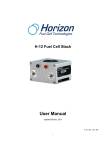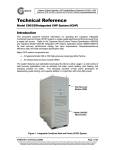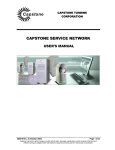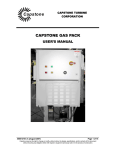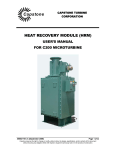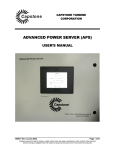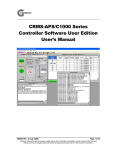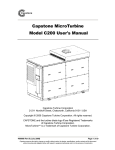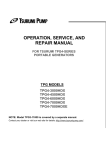Download Technical Reference
Transcript
Capstone Capstone Turbine Corporation • 21211 Nordhoff Street • Chatsworth • CA 91311 • USA Telephone: (818) 734-5300 • Facsimile: (818) 734-5320 • Website: www.microturbine.com Technical Reference Gaseous System Technical Information Introduction This document provides product information for Capstone Turbine Corporation® MicroTurbines operating on approved low-pressure and high-pressure gaseous fuels. Fuels can vary in physical composition, higher heating (HHV) value and contaminant limitations. See the MicroTurbine Fuel Requirements Technical Reference 410002 for further details. Fuel system types covered in this document are: High/Low Pressure Natural Gas (HPNG/LPNG), Landfill/Digester or Biogas, and Sour Gas. These types are collectively referred to as: High Pressure and Low Pressure Natural Gas systems. High Pressure Natural Gas descriptions apply to both stationary and hybrid electric vehicle (HEV) models. Model C30 Natural Gas systems are available in several packages: standard, open, industrial or Small Industrial Package (SIP) models. Model C60 systems are available only in the Large Industrial Package (LIP). Available configurations for low-pressure and high-pressure systems are shown below: Standard or Open Package Industrial Package Small Industrial Package (SIP) or HEV Large Industrial Package (LIP) – C60 only 410037-001 Rev B (January 2006) Page 1 of 15 This information is proprietary to Capstone Turbine Corporation. Neither this document nor the information contained herein shall be copied, disclosed to others, or used for any purposes other than the specific purpose for which this document was delivered. Capstone reserves the right to change or modify without notice, the design, the product specifications, and/or the contents of this document without incurring any obligation either with respect to equipment previously sold or in the process of construction. Capstone Turbine Corporation • 21211 Nordhoff Street • Chatsworth • CA 91311 • USA Technical Reference: Gaseous System Technical Information High Pressure Gas System Components High-pressure gaseous fuel components (C60 – Large Industrial Package shown) are identified below: NOTE Component descriptions are provided in the Components Description Technical Reference Manual (410012). Smart Proportional Valve (SPV) To Fuel Manifold Injector Lines Gaseous Filter Electrical Fuel Shutoff Valve Fuel Inlet Top View Injector Tube Connections To Fuel Manifold Electrical Fuel Shutoff Valve Smart Proportional Valve (SPV) Side View 410037-001 Rev B (January 2006) Page 2 of 15 This information is proprietary to Capstone Turbine Corporation. Neither this document nor the information contained herein shall be copied, disclosed to others, or used for any purposes other than the specific purpose for which this document was delivered. Capstone reserves the right to change or modify without notice, the design, the product specifications, and/or the contents of this document without incurring any obligation either with respect to equipment previously sold or in the process of construction. Capstone Turbine Corporation • 21211 Nordhoff Street • Chatsworth • CA 91311 • USA Technical Reference: Gaseous System Technical Information Low Pressure Gas System Components Low-pressure fuel system components (C30 - Standard Package shown) are identified below: NOTE Component descriptions are provided in the Components Description Technical Reference Manual (410012). Heat Exchanger Vacuum Pressure Switch Rotary Flow Controller (RFC) RFC Exit Pressure Transducer Inlet Gas Connection Smart Proportional Valve (SPV) Screen Inlet Fuel Filter Electrical Fuel Shutoff Valve Premix Fuel Lines to Injectors Pilot Fuel Lines to Injectors Pilot Injector Solenoids Fuel Manifold Fuel from SPV Premix Solenoid Exit Pressure Transducer 410037-001 Rev B (January 2006) Page 3 of 15 This information is proprietary to Capstone Turbine Corporation. Neither this document nor the information contained herein shall be copied, disclosed to others, or used for any purposes other than the specific purpose for which this document was delivered. Capstone reserves the right to change or modify without notice, the design, the product specifications, and/or the contents of this document without incurring any obligation either with respect to equipment previously sold or in the process of construction. Capstone Turbine Corporation • 21211 Nordhoff Street • Chatsworth • CA 91311 • USA Technical Reference: Gaseous System Technical Information System Operation High-Pressure Natural Gas A block diagram of a Model C30 high-pressure natural gas fuel system is shown below. SCREEN INLET FILTER FUEL INLET ELECTRICAL SHUTOFF SOLENOID P FUEL MANIFOLD SPV PILOT INJECTOR LINES INJECTOR SOLENOIDS 1 HIGH PRESSURE FUEL OPTION KIT 507849-1XX 2 3 TURBINE PREMIX INJECTOR LINES 1 2 3 A block diagram of a Model C60 high-pressure natural gas fuel system is shown below. FUEL INLET SCREEN INLET FILTER ELECTRICAL SHUTOFF SOLENOID P FUEL MANIFOLD SPV INJECTOR SOLENOIDS HIGH PRESSURE FUEL OPTION KIT 507849-1XX 1 TURBINE 2 3 4 5 6 410037-001 Rev B (January 2006) Page 4 of 15 This information is proprietary to Capstone Turbine Corporation. Neither this document nor the information contained herein shall be copied, disclosed to others, or used for any purposes other than the specific purpose for which this document was delivered. Capstone reserves the right to change or modify without notice, the design, the product specifications, and/or the contents of this document without incurring any obligation either with respect to equipment previously sold or in the process of construction. Capstone Turbine Corporation • 21211 Nordhoff Street • Chatsworth • CA 91311 • USA Technical Reference: Gaseous System Technical Information Natural gas enters the MicroTurbine package inlet and is passed through a gaseous filtering element to eliminate particulates from the fuel. Filtered fuel flows through an electrical fuel shutoff valve, which is commanded on for operation. The fuel shutoff valve protects the MicroTurbine by cutting off fuel to the MicroTurbine in case of a fault condition. The Smart Proportional Valve (SPV) controls fuel flow into the fuel manifold, and subsequently into the injectors, based on a software-controlled position command. Maximum fuel supply to the injectors is delivered at a command of 80 percent valve position. The fuel manifold contains electrically controlled solenoids, which directs fuel flow through the injectors. The number of injectors depends on the MicroTurbine model. On a Model C30, four solenoids control fuel flow into the three injectors – there are three pilot solenoids and a single premix solenoid. On a Model C60, there are five solenoids - one solenoid activates injectors 1 and 2, the others individually turn on injectors 3, 4, 5 and 6. 410037-001 Rev B (January 2006) Page 5 of 15 This information is proprietary to Capstone Turbine Corporation. Neither this document nor the information contained herein shall be copied, disclosed to others, or used for any purposes other than the specific purpose for which this document was delivered. Capstone reserves the right to change or modify without notice, the design, the product specifications, and/or the contents of this document without incurring any obligation either with respect to equipment previously sold or in the process of construction. Capstone Turbine Corporation • 21211 Nordhoff Street • Chatsworth • CA 91311 • USA Technical Reference: Gaseous System Technical Information Low Pressure Natural Gas A block diagram of a Model C30 low-pressure natural gas system is shown below (dotted line for pressure transducer indicates this component has been eliminated in later models): VACUUM SWITCH FUEL INLET SCREEN INLET FILTER P ELECTRICAL SHUTOFF SOLENOID RFC P NOTE: Transducer eliminated in later SIP models FUEL MANIFOLD HEAT EXCHANGER SPV PILOT INJECTOR LINES INJECTOR SOLENOIDS 1 LOW PRESSURE FUEL OPTION KIT 507849-2XX 2 3 TURBINE PREMIX INJECTOR LINES 1 2 3 Natural gas entering the MicroTurbine is monitored for fuel pressure by a protective vacuum (pressure) switch. If close to vacuum conditions are detected, operation ceases and a 3024 LOW FUEL PRESSURE fault is reported. An inlet screen filter to the electrical shutoff valve restricts larger fuel particulates from clogging the system. If a fault condition exists, the electrical fuel shutoff valve closes to stop fuel flow into the MicroTurbine; otherwise it is commanded open to maintain fuel flow to the MicroTurbine during system operation. The Foil Bearing Rotary Flow Compressor (FB-RFC) compresses the low-pressure fuel supply up to the required fuel system operating pressure. The RFC operates as a gas compressor at low fuel rates and a flow control device at high fuel flow rates. The compressed high-temperature gas from the RFC is pressure monitored and cooled via a heat exchanger before entering the SPV. The SPV and RFC work together to control fuel flow. At low power levels, the RFC operates at a constant speed and the controlling orifice in the SPV meters fuel. At high power levels, the SPV is commanded to a maximum open position, and the flow is metered by varying the speed of the RFC. A vacuum switch is present on the gas inlet to the fuel system to ensure that the fuel pressure is nominally maintained above ambient pressure conditions. This protects the RFC from operating under gas-starved conditions that could damage the foil bearings (i.e., the gas supply is shut off during system operation). The fuel manifold contains electrically-controlled solenoids, which direct injector fuel flow. On earlier low-pressure configurations, exit pressure is monitored through a transducer mounted on the fuel manifold. In later models (SIP configuration), this transducer has been eliminated. Low Pressure natural gas systems may require additional considerations or fuel option kits to deal with inlet fuel pressures above or below nominal pressures. 410037-001 Rev B (January 2006) Page 6 of 15 This information is proprietary to Capstone Turbine Corporation. Neither this document nor the information contained herein shall be copied, disclosed to others, or used for any purposes other than the specific purpose for which this document was delivered. Capstone reserves the right to change or modify without notice, the design, the product specifications, and/or the contents of this document without incurring any obligation either with respect to equipment previously sold or in the process of construction. Capstone Turbine Corporation • 21211 Nordhoff Street • Chatsworth • CA 91311 • USA Technical Reference: Gaseous System Technical Information Injector Operation Model C30 The Model C30 MicroTurbine utilizes three pilot injector solenoids (1, 2 and 3), and a single premix solenoid to control fuel flow to the engine. Each injector delivers fuel from two points of entry – directly from the pilot tube, or through the premix tube. The pilot tubes supply fuel directly into the combustion chamber, mixing with air from the recuperator. The premix tubes utilize air from the recuperator through swirl holes in the injector, prior to entering the combustion chamber. Pilot Premix Injector operation changes at different power levels (ISO corrected generator power). Power levels for each injector switch point decrease by approximately 2 kW due to hysterisis effects during offloading. • Below 7 kW, the MicroTurbine operates with a single pilot injector. • From 7 kW to 22 kW, all three pilot injectors are switched on. • Above 22 kW, all three pilot solenoids are turned off, and the premix solenoid is switched on. Air Mix Swirl Holes C30 Injector To increase flame stability with medium or low BTU content fuels, the sequencing of the fuel solenoids changes based on the BTU content value selected. For a BTU content setting of medium, the system will light on three pilot injectors and switch to premix mode as noted above. Medium BTU systems will never operate in single pilot mode. For a BTU content setting of low, the system will light and always operate in premix mode. The pilot solenoids will never be used. Refer to the BTU Content Switch section for information on this setting. Model C60 The Model C60 MicroTurbine utilizes five injector solenoids, located on the fuel manifold for controlling fuel flow into six injector ports of the engine. Premix Injectors 1 and 2 are always on and are controlled by a single solenoid. Injectors 3 thru 6 are operated by separately controlled solenoids. The C60 always operates in premix mode. Injector operation changes at different power levels (ISO corrected generator power). Power levels for each injector switch point decrease by approximately 3 kW due to hysterisis effects during offloading. • The MicroTurbine initially lights using injectors 1 and 2 (one solenoid operates both injectors). • Above 15 kW, third injector turns on (turns off at ~12 kW). • Above 26 kW, fourth injector turns on (turns off at ~23 kW). • Above 43 kW, fifth injector turns on (turns off at ~40 kW). • Above 54 kW, sixth injector turns on, and all six are in operation (turns off at ~51 kW). 410037-001 Rev B (January 2006) Air Mix Entrance C60 Injector Page 7 of 15 This information is proprietary to Capstone Turbine Corporation. Neither this document nor the information contained herein shall be copied, disclosed to others, or used for any purposes other than the specific purpose for which this document was delivered. Capstone reserves the right to change or modify without notice, the design, the product specifications, and/or the contents of this document without incurring any obligation either with respect to equipment previously sold or in the process of construction. Capstone Turbine Corporation • 21211 Nordhoff Street • Chatsworth • CA 91311 • USA Technical Reference: Gaseous System Technical Information Fuel Selection and Utilization Allowable Fuels The MicroTurbine is capable of burning a wide variety of gaseous fuels to generate electrical power. A Model C30 low BTU fuel system option can provide for operation from 13,000 (350) to 26,100 kj/NM3 (760 BTU/scf). This option requires higher fuel gas supply pressures and is not available in combination with the low-pressure fuel system. For more information regarding fuels allowed on different system configurations, refer to the MicroTurbine Fuel Requirements Technical Reference (410002). Specifying Fuel Characteristics As shipped, the MicroTurbine is configured for standard natural gas fuel. If gaseous fuels with physical characteristics other than standard natural gas fuel are used, information on the physical characteristics of these fuels may be entered into the system to ensure that: a) Flame stability margins are maintained, and b) NOx exhaust emissions are minimized. Fuel Indices The MicroTurbine incorporates fuel gas physical characteristics into the control functions in the form of the fuel indices defined as follows: NOTE Index parameters must meet requirements stated in the MicroTurbine Fuel Requirements Technical Reference (410002). FUELI1 = SG * 1327 HHVvol 2 FUELI2 - (Not currently used on gaseous fuel systems) where: SG = fuel gas specific gravity, with respect to air HHVvol = fuel gas higher heating value, BTU/scf Fuel Index 1 (FUELI1) is a parameter related to the fuel density and energy content. If the FUELI1 parameter entered differs by more than 15 percent from the index for the actual fuel being burned, nuisance flameout or over-temperature faults may occur. Setting adjustments may be entered through the display panel keypad, or remotely, through the user interface port (UIP) upon commissioning of the system. Table 1 shows the values of FUELI1 for common fuel gases. Fuel Index 2 (FUELI2) is not currently used on gaseous fuel systems. The specific gravity (SG) and higher heating value (HHVvol) of commercial natural gas fuels may be obtained from the local natural gas supplier. Gas chromatographic analyses of noncommercial fuel gases commonly report calculated specific gravity and higher heating value. 410037-001 Rev B (January 2006) Page 8 of 15 This information is proprietary to Capstone Turbine Corporation. Neither this document nor the information contained herein shall be copied, disclosed to others, or used for any purposes other than the specific purpose for which this document was delivered. Capstone reserves the right to change or modify without notice, the design, the product specifications, and/or the contents of this document without incurring any obligation either with respect to equipment previously sold or in the process of construction. Capstone Turbine Corporation • 21211 Nordhoff Street • Chatsworth • CA 91311 • USA Technical Reference: Gaseous System Technical Information BTU Content Setting As the energy content of fuel gas decreases, so does flame stability. To maintain acceptable flame stability below 970 BTU/scf HHV on Landfill /Digester and Sour Gas Model C30 systems, adjustments in fuel system sequencing are required. The BTU Content switch enables these adjustments. System Settings Menu BTU Content Variable BTU <FUELI1> Parameter Description (BTU/scf HHV) Format Normal for 970 – 2516 Medium for 760 – 970 Low for 350 – 760 Normal Medium Low FUELI1 as defined above 0.10 – 99.99 Default Normal 1.00 Table 1. Fuel Indices for Common Fuel Gases Specific Gravity (w/ respect to air) HHVvol High Heating Value (BTU/scf) Natural Gas Baseline 0.613 1,039 1.00 Normal Methane 0.554 1,013 0.95 Normal Ethane 1.049 1,792 0.58 Normal Propane 1.562 2,592 0.41 Normal Digester gas (max) 0.959 672 3.74 Low Digester gas (avg) 0.909 607 4.34 Low Digester gas (min) 0.862 363 11.49 Low Landfill gas (max) 1.004 674 3.90 Low Landfill gas (avg) 0.973 496 6.96 Low Landfill gas (min) 0.995 355 13.94 Low Fuel Name 410037-001 Rev B (January 2006) FUELI1 BTU Content Switch Page 9 of 15 This information is proprietary to Capstone Turbine Corporation. Neither this document nor the information contained herein shall be copied, disclosed to others, or used for any purposes other than the specific purpose for which this document was delivered. Capstone reserves the right to change or modify without notice, the design, the product specifications, and/or the contents of this document without incurring any obligation either with respect to equipment previously sold or in the process of construction. Capstone Turbine Corporation • 21211 Nordhoff Street • Chatsworth • CA 91311 • USA Technical Reference: Gaseous System Technical Information If values of the specific gravity and/or higher heating value are not available, they may be calculated from the gas composition. A sample calculation is provided in Table 2. Table 2. Sample Calculation, Oil Wellhead Gas 1 Gas Component 2 Symbol 5 6 7 3 4 Concentration (SG) HHVvol (SG) HHVvol (Volume %) (Col 3 * Col 5) (Col 4 *Col 5) (WRT Air) (BTU/Scf) Hydrogen H2 0.0695 325 - - - Carbon Monoxide CO 0.9672 322 - - - Methane CH4 0.5541 1013 61% 0.338 618 Ethane C2H6 1.0488 1792 26% 0.2727 466 Ethylene C2H4 0.974 1613 - - - Propane C3H8 1.5624 2592 5% 0.0781 130 Propylene C3H6 1.45 2336 - - - N-Butane C4H10 2.0666 3373 2% 0.0613 67 Iso-Butane C4H10 2.0666 3365 - - - N-Pentane C5H12 2.4872 4017 1% 0.0249 40 Iso-Pentane C5H12 2.4872 4007 - - - Hyrogen Sulfide H2S 1.1899 646 2% 0.0238 13 Carbon Dioxide CO2 1.5284 - 3% 0.0459 - Nitrogen N2 0.9717 - - - - Oxygen O2 1.1053 - - - - H2O 0.6215 - - - - Total 100% 0.8447 1334 Water Vapor FUELI1 = 0.8447 * 1327 2 = 0.84 1334 410037-001 Rev B (January 2006) Page 10 of 15 This information is proprietary to Capstone Turbine Corporation. Neither this document nor the information contained herein shall be copied, disclosed to others, or used for any purposes other than the specific purpose for which this document was delivered. Capstone reserves the right to change or modify without notice, the design, the product specifications, and/or the contents of this document without incurring any obligation either with respect to equipment previously sold or in the process of construction. Capstone Turbine Corporation • 21211 Nordhoff Street • Chatsworth • CA 91311 • USA Technical Reference: Gaseous System Technical Information Installation Requirements A main filter must be installed external to the MicroTurbine. A pressure regulator is usually required to maintain steady fuel pressure at the MicroTurbine inlet. The inlet pressure must remain at or above the minimum requirement during load and during cold (maximum fuel flow) conditions. Fuel Option Kits available from Capstone provide the necessary manual fuel isolation valve, external fuel filter, purge valve and pressure regulator needed for a standard installation. Contact Capstone Technical Support for details on the Fuel Option kits specified below: Part Number Description Remarks 507849-1XX High Pressure External Gaseous Fuel Kit Pressure regulator, gauge, manual shutoff valve and filtration 507849-2XX Low Pressure External Gaseous Fuel Kit Manual shutoff valve and filtration 508604-1XX Sour Gas External Gaseous Fuel Kit Pressure regulator, gauge, manual shutoff valve and filtration Commissioning the System The MicroTurbine inlet pressure requirements are defined in Tables 3 and 4. The inlet fuel gas supply must be maintained at minimum pressure at the maximum flow rate for proper operation. An adequate fuel supply pressure without pressure loss at high flow rates is ESSENTIAL for proper MicroTurbine operation. Due to inlet pressure requirements, many applications require external compressors. Capstone can provide optional Fuel Gas Booster (FGB) kits that can be operated using MicroTurbine power for Stand Alone installations. Refer to the Capstone Fuel Gas Booster Installation Instructions (410016) for details. Special Biogas fuel processing considerations in meeting liquid fuel particulate requirements can be found in the Landfill/Digester Biogas Gas Usage (Biogas) Application Guide (480002). 410037-001 Rev B (January 2006) Page 11 of 15 This information is proprietary to Capstone Turbine Corporation. Neither this document nor the information contained herein shall be copied, disclosed to others, or used for any purposes other than the specific purpose for which this document was delivered. Capstone reserves the right to change or modify without notice, the design, the product specifications, and/or the contents of this document without incurring any obligation either with respect to equipment previously sold or in the process of construction. Capstone Turbine Corporation • 21211 Nordhoff Street • Chatsworth • CA 91311 • USA Technical Reference: Gaseous System Technical Information Table 3. Gaseous Fuel Supply Pressure and Temperature Requirements Supply Pressure in kPa (Gage (psig)) System Supply Temperature in °C (°F) LSL USL LSL USL C30 HP 379 (55) (Note 2) 414 (60) (Notes 2,3) Note (4) 50 (122) C30 LP 1.4 (0.20) 103 (15) Note (4) 50 (122) C30 SG 379 (55) (Note 2) 414 (60) (Note 2) Note (4) C30 L/DG (Note 3) (Note 3) Note (4) 50 (122) C60 HP 517 (75) 552 (80) Note (4) 50 (122) C60 HP/ ICHP 517 (75) 552 (80) Note (4) 50 (122) C60 LP (Note 1) 3.4 (0.50) 103 (10) Note (4) 50 (122) 3.4 (0.50) 103 (10) Note (4) 50 (122) C60 LP/ ICHP (Note 1) 50 (122) Notes: (1) Low pressure gas can be used when C60 HP, C60 HP ICHP is integrated with Capstone Integrated Fuel System Optional Accessory. (2) Fuels with Calorific Value greater than Natural Gas Range or Sour Natural Gas Range may require lower inlet pressures, down to 310 kPa (45 psig). (3) This item is dependent upon the fuel Calorific Value as noted in Table 4. (4) This value must be the highest of 0 °C (32 °F), or 10 °C (18 °F) above the fuel dew point temperature at the Fuel Supply Pressure Maximum noted in this table. Table 4. L/DG Fuel Supply Pressure Requirements Calorific Value (HHV) [MJ/m3 (Btu/ft3)] Supply Pressure [kPa Gage (psig)] LSL USL LSL USL 26.1 (700) 38.4 (1,030) 345 (50) 379 (55) 22.4 (600) 26.1 (700) 345 (50) 414 (60) 18.6 (500) 22.4 (600) 379 (55) 448 (65) 16.8 (450) 18.6 (500) 414 (60) 483 (70) 14.9 (400) 16.8 (450) 448 (65) 517 (75) 12.1 (325) 14.9 (400) 483 (70) 552 (80) 410037-001 Rev B (January 2006) Page 12 of 15 This information is proprietary to Capstone Turbine Corporation. Neither this document nor the information contained herein shall be copied, disclosed to others, or used for any purposes other than the specific purpose for which this document was delivered. Capstone reserves the right to change or modify without notice, the design, the product specifications, and/or the contents of this document without incurring any obligation either with respect to equipment previously sold or in the process of construction. Capstone Turbine Corporation • 21211 Nordhoff Street • Chatsworth • CA 91311 • USA Technical Reference: Gaseous System Technical Information Diagnostic Faults Detailed explanation of all gas-related diagnostic faults is available in the Model C30 Troubleshooting Guide (430000), and Model C60 Troubleshooting Guide (430013). Some of the more common fuel system faults that may appear are listed below. Sensor Faults Fault No. 3024 Fault Description LOW FUEL PRESSURE SSL 3 Isolation Message Internal Fault 3026 LOW FUEL AIR PRESSURE 3 Internal Fault 3027 HIGH FUEL AIR PRESSURE 3 Internal Fualt 3029 RFC AIR ASSIST FAILURE 3 Fuel Fault 3031 RFC LOW FUEL PRESSURE 3 Fuel Fault SSL 3 Isolation Message Internal Fault 3 Internal Fault SSL 3 Isolation Message Internal Fault Package Faults Fault No. 5000 Fault Description FUEL SUBSYSTEM 5001 NO FUEL DEVICE Operational Faults Fault No. 6006 Fault Description FAIL TO LIGHT 6009 OVERTEMP 3 Internal Fault 6010 HIOVERTEMP 3 Internal Fault 6011 FLAMEOUT_START 3 Internal Fault 6012 FLAMEOUT_LOAD 3 Internal Fault 410037-001 Rev B (January 2006) Page 13 of 15 This information is proprietary to Capstone Turbine Corporation. Neither this document nor the information contained herein shall be copied, disclosed to others, or used for any purposes other than the specific purpose for which this document was delivered. Capstone reserves the right to change or modify without notice, the design, the product specifications, and/or the contents of this document without incurring any obligation either with respect to equipment previously sold or in the process of construction. Capstone Turbine Corporation • 21211 Nordhoff Street • Chatsworth • CA 91311 • USA Technical Reference: Gaseous System Technical Information Maintenance Items Scheduled maintenance intervals for component parts are summarized in the MicroTurbine Standard Maintenance Schedule (440000). Related Documentation The following table lists applicable Capstone documentation. Document No. Document Title 400000 Capstone MicroTurbine Users Manual 410002 Capstone MicroTurbine Fuel Requirements Technical Reference 410012 Capstone Components Description Technical Reference 410013 Capstone Remote Monitoring System (Users Edition) Technical Reference 410016 Capstone Fuel Gas Booster Installation Instructions 430000 Capstone Model C30 Troubleshooting Guide 430002 Capstone Model C30 Service Manual 430013 Capstone Model C60 Troubleshooting Guide 430017 Capstone Model C60 Service Manual 440000 Capstone MicroTurbine Standard Maintenance Schedule Work Instructions 480002 Capstone Landfill/Digester Gas Usage (Biogas) Application Guide 410037-001 Rev B (January 2006) Page 14 of 15 This information is proprietary to Capstone Turbine Corporation. Neither this document nor the information contained herein shall be copied, disclosed to others, or used for any purposes other than the specific purpose for which this document was delivered. Capstone reserves the right to change or modify without notice, the design, the product specifications, and/or the contents of this document without incurring any obligation either with respect to equipment previously sold or in the process of construction. Capstone Turbine Corporation • 21211 Nordhoff Street • Chatsworth • CA 91311 • USA Technical Reference: Gaseous System Technical Information Capstone Technical Information If questions arise regarding Natural Gas operation for your Capstone MicroTurbine, please contact Capstone Turbine Technical Support for assistance and information. Capstone Technical Support Toll Free Telephone: (877) 282-8966 Service Telephone: (818) 407-3600 • Fax: (818) 734-1080 E-mail: [email protected] Capstone Technical Support (Japan) Service Telephone: (818) 407-3700 • Fax: (818) 734-1080 E-mail: [email protected] Capstone Turbine Corporation 21211 Nordhoff Street • Chatsworth, CA 91311 • USA Telephone: (818) 734-5300 • Fax: (818) 734-5320 Website: www.microturbine.com 410037-001 Rev B (January 2006) Page 15 of 15 This information is proprietary to Capstone Turbine Corporation. Neither this document nor the information contained herein shall be copied, disclosed to others, or used for any purposes other than the specific purpose for which this document was delivered. Capstone reserves the right to change or modify without notice, the design, the product specifications, and/or the contents of this document without incurring any obligation either with respect to equipment previously sold or in the process of construction.















